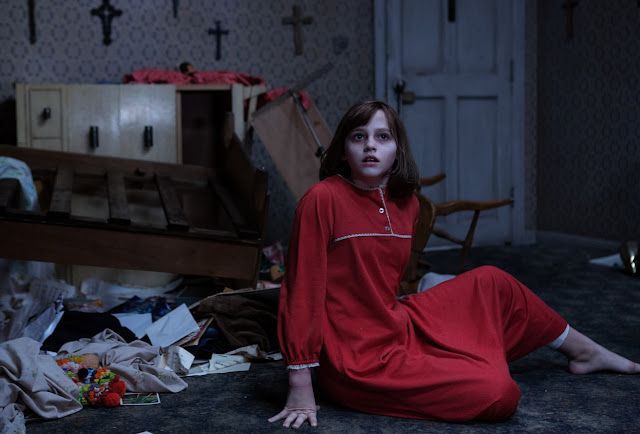“An inventive deep-layered modern animated film classic.”
Going through different stages of life can be very
difficult. We may opt to look for the brighter side and appear happy, but deep
inside, there is a turmoil of emotions that have to be honestly expressed to
give us some sense of liberation. In Pixar’s comedy adventure film Inside Out, we will journey into the
world inside our minds and discover how our emotions are at work.
Set in the mind of 11-year-old Riley Anderson (Kaitlyn Dias), the film tells how our action and reactions by affected by the interplay
of five elemental emotions: Joy (Amy Poehler) who looks like a yellow
cheerleader-type wingless Tinkerbell, blue teardrop-shaped Sadness (Phyllis Smith), scrawny and purplish insect-like Fear (Bill Harder), rich green and
snobby Disgust (Mindy Kalling), and Anger (Louis Black) who appears like a red
flat-top white-collar worker. They process memories in the master control room
and store them in color-coded orbs. From the control room, there is a tube-type
delivery and sorting system which transports the memory balls to the deeper
interior of the mind. There, they are classified into short-term or long-term
memories, or are tossed into an “abyss” where they dissolve into oblivion. Much
of the orbs are stored in the “islands” of Riley’s personality such as goofy,
honesty, hockey, friendship and family.
Because of her father’s new tech job, Riley moves from
Minnesota to San Francisco with her mom (Diane Lane) and dad (Kyle MacLachla).
Joy presumes control over everything as she sees that Riley’s best option to
adjust to her new life is by being positive and bringing out fond memories.
Despite being depressed with the move, Riley tries hard to be happy. However,
Sadness feels an urge to touch the orbs and when she does so, Riley becomes
weepy as she introduces herself to the new class. A struggle ensues between Joy
and Sadness, and by accident, they are vacuumed up along with some “core
memories” into the interior. While Fear, Anger and Disgust struggle to run the
show for Riley, Joy and Sadness must find their way along her world of memories
and stop her from committing a grievous mistake.
Inside Out is an
inventive and refreshing offering from Pixar and from Pete Docter, director of
modern animation classics like Monster,
Inc (2001) and Up (2009). The film
appears nothing much on the surface as it merely tells about a girl’s
adjustment to a new neighborhood and to puberty. But as the movie progresses, the
movie shows deeper layers as it tenders a unique form of storytelling, deviating
much from overused animation conventions. It is not science fiction as
emotions, which are actually headquartered in our minds, are represented in
metaphors. It is neither a fantasy as the subject is rooted in reality and real
life. It is a class of its own with its clever creativity and stunning visuals.
The “Imagination Land” through the “Abstract Thought,” the “Train of Thought,”
and the production studio of dreams and nightmares are other wise and ingenious
details of the film.
In particular,
the interplay between Riley, Dad and Mom during dinner is a notable fun part of
the movie. While Fear, Anger and Disgust controls Riley’s reactions, similar emotional
sprites are inside Dad’s and Mom’s head, doing the necessary actions to their
child’s sudden aggressive behavior. In reality, the family are already in a
heated argument. Combining gracefully such conflict and amusement in one
sequence is truly praiseworthy.
Perhaps, the most heart-warming parts in the movie revolve
around Bing-Bong (Richard Kind), Riley’s pink elephantine cotton candy-body childhood
imaginary friend. Lost in the interior, Bing-Bong desperately seeks ways to
reconnect with Riley via his red wagon that leaves a rainbow trail. Much to Joy’s
wonder, Bing-Bong finds solace in Sadness. In his final heart-rending moment,
Bing-Bong opts to be left behind in the abyss in order for Joy to be reunited with
her team. As he watches long-forgotten memory balls dissolve in Riley’s mind,
he also finds himself fading away. But certainly, like Pixar’s other iconic characters
like Nemo and Wall-E, Bing-Bong will never ever be forgotten from our memories.
On
a deeper note, Inside Out teaches us
that memories can be remembered differently. No emotion can overrule another as
they touch our soul differently. An example is Riley’s childhood memory where
she missed a shot in a hockey game. It was Sadness that urged her family and
team to console her and make her happy again. In Riley’s depression over the
sudden move into another home, she experiences emotional chaos inside her, but
it is her sadness and longing for her fond old memories that make her reach out
to her parents again. Inside, tons of orbs are dumped into the abyss while
islands shatter one by one. Yet, from these grey rubbles rise new islands and
new memories.
Inside Out reaches out to both children and adults. For the young
ones, the spectacular animation and dramatic adventures are awe-inspiring. For the
mature minds, the superb images are reminders of one’s honesty of feelings to oneself. A
blissful spirit is handy as we journey through life. But through periods of
trials and hardships, it is alright to break down and cry, and even get angry or
disgusted at things. For in this moment of weakness and truthfulness we shall
derive comfort and genuine joy from the people who care for us.



























0 comments:
Post a Comment